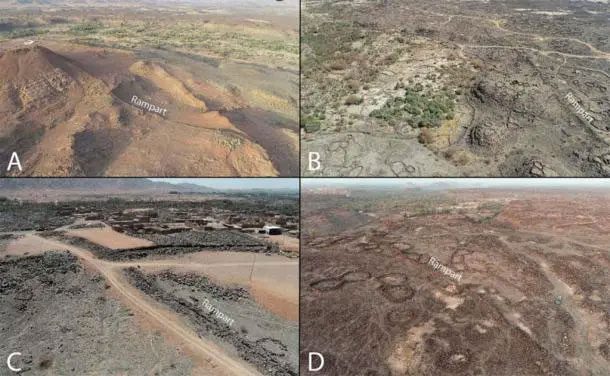The ancient fortress has been fully revealed following a large-scale archaeological survey combining remote sensing, fieldwork, and architectural research.
According to a publication in the Journal of Archaeology Science: Reports by an archaeological team from the French National Centre for Scientific Research (CNRS) and the Royal Commission for AlUla (RCU) in Saudi Arabia, the ancient fortress is a magnificent “fortress oasis.”
Known as the Khaybar Oasis, this architectural complex features an impressive protective wall that stretches 14.5 km long, 1.7-2.4 m wide, and rises up to 5 m high. Inside lies a complex settlement covering nearly 1,100 hectares.

Ruins of the ancient fortress recently discovered in Saudi Arabia – (Photo: Journal of Archaeology Science: Reports).
The fortress wall is one of the longest known ancient structures in the world, dating back to an astonishing period: approximately 2250 to 1959 BCE.
According to Ancient Origins, the Khaybar Oasis, along with the previously discovered Taima Oasis, represents the largest walled oasis ever excavated in Saudi Arabia, showcasing an ancient settlement form that commands global admiration.
The Arabian Peninsula is renowned as a cradle of civilization, where societies have developed exceptionally complex systems for millennia. Ancient fortresses built on oases like Khaybar serve as prime examples.
Khaybar and other ancient fortresses dominating similar oases marked important social and territorial points during that era.
These locations provided good water resources and rare favorable environments amidst the desert to foster agriculture and livestock, serving as hubs for ancient trade.
Excavations within the grand protective wall have revealed various burial structures, indigenous dry-stone walls, and numerous inscriptions and rock art representing diverse periods and traditions.
This ancient fortress is also identified as a cradle of local history in the northwestern region of Saudi Arabia, where settlement activities have never ceased despite aridity, even with slight shifts in location.
Inhabitants of Saudi Arabia and across the ancient Arabian Peninsula are believed to have developed advanced wetland construction techniques, irrigation canal systems, and maximized the use of oases in the desert early on.
Several ancient fortress types known as “fortress oases” with slightly more recent dates have also been discovered in the region, including robust structures akin to the “super fortresses” of Europe.



















































